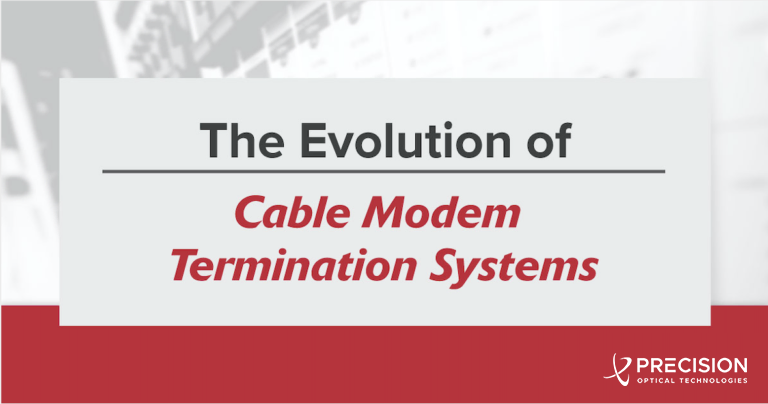
The Evolution of Cable Modem Termination Systems

In an ever-changing world, everything must evolve in order to stay relevant. This is certainly true of today’s MSO access networks. With increased utilization of data-intensive applications involving IP video, HD TV, online gaming and other OTT services, MSOs have found that their legacy network architectures can’t keep pace with the bandwidth needs of their subscribers.
In a previous blog, we talked about the general effects distributed access architectures like Remote-PHY (R-PHY) have on improving the capabilities of legacy HFC topologies. Here, we examine the evolution of MSO networks in a bit more detail by focusing on R-PHY’s effect on one of the most critical components of an MSO’s network – the Cable Modem Termination System.
You Can’t Serve Subscribers Without a CMTS
As you likely know, a cable modem termination system (CMTS) is a component that exchanges digital signals with cable modems on a cable network. The CMTS enables MSOs to manage the connections between their subscribers and the internet. Let’s deconstruct the classic architecture a bit. The CMTS, located in an MSO’s headend, receives signals via the HFC network from subscriber cable modems, which are grouped into access nodes. The CMTS then converts those signals into IP packets and sends them through a switch to a router for outbound transmission across the internet.
Of course, different CMTSs can serve different numbers of nodes and cable modems. Some headends require more than one CMTS in order to ensure the MSO’s network can handle the entire cable modem population within the nodes. A CMTS usually has both an Ethernet (or SONET, etc.) and RF interface. The CMTS receives downstream traffic via the Ethernet interface, which then leaves outbound via an RF interface connected to the HFC network. Upstream traffic passes from cable modems to the internet in reverse.
Here’s where CMTS design gets interesting from an evolution perspective. MSOs are familiar with two types of CMTS architectures – integrated and modular. An integrated CMTS keeps all its components within one chassis, while a modular CMTS, as you might guess, is broken up into a PHY (Edge QAM) and a DOCSIS MAC Component called the Core. It is the modular CMTS that, over the past few years, has provided the evolutionary starting point for next generation MSO access networks and a shift in the relationship between the node and the CMTS.
From Centralized to Distributed: The New CMTS – Node Relationship
As MSOs evolve to meet the bandwidth demands of their subscribers and stay competitive with pure fiber-based architectures like FTTH, they are turning to Distributed Access Architectures (DAA). By virtualizing and decentralizing headend and network functions, DAA can increase the available bandwidth of MSO’s existing HFC network infrastructure. How does this happen, exactly?
Under a Remote-PHY DAA architecture, the physical layer of the OSI model gets moved from the headend CMTS out to the digital fiber nodes toward the end of the network, closer to the subscriber cable modems. To boil this down even further, by moving the PHY circuit (or EQAM) portion of the traditional CMTS into the access node, the analog fiber running between the headend and the node becomes digital, enabling greater throughput.
With Remote MAC-PHY, both the physical and the media access control (MAC) portions of the CMTS get moved to the node. Essentially, the node gains much of the power of the traditional headend CMTS. With just Remote-PHY, the CMTS core gets to remain in the headend where it takes care of the MAC layer. Remote MAC-PHY takes DAA a step further by distributing another vital component of the CMTS to the node. Made possible by the previous introduction of modular CMTSs into service, Remote-PHY and Remote MAC-PHY represent a huge shift in the CMTS – node relationship. Where once they were separate, now their conceptual and physical presence in an MSO’s next-generation HFC network overlaps.
The Future of CMTS Evolution: Toward Complete Virtualization
As MSOs grapple with ensuring they do not run out of capacity from subscriber demand, Remote-PHY and Remote MAC-PHY offer the next foundational steppingstone in improving network bandwidth and affordability, especially from a real estate perspective. Here, virtualization is proving to be an attractive option. Building upon the modular CMTS and Remote-PHY foundation, some MSOs are already working toward shifting the routing of traffic and modem management into a completely virtualized environment.
Simply put, MSOs are beginning to move away from purpose-built CMTS hardware to software-based platforms that can run on less costly servers. Instead of having the operating system of a CMTS run directly on the headend chassis, an MSO can let virtual machines provide the CMTS functionality they require. This holds the potential to create savings on power, space and cooling within the headend. In fact, as virtualization increases in popularity, MSOs get even greater flexibility in terms of how they design their architectures. Essentially, they could place their server(s) running the virtual DOCSIS software in a hub site, a headend or even a data center. Although virtualization technology is still in its infancy, it holds the potential to transform the cable industry over the next several years.
Why Precision OT
As enablers of advancements in networking architectures, we offer the high-quality optical equipment that makes such evolutions possible. With an extensive inventory of digital return optics and 10G SFP+ tunable transceivers for Remote-PHY applications, network operators can enjoy fast delivery of the cutting-edge technology they need. NEM-compatible, customizable and backed by a lifetime warranty, our Tier-1 transceivers can speed time to market for our customers looking to establish their own reliable, robust DAA.
To find out how Precision OT can create a custom solution that suits your specific Remote-PHY or other DAA needs, contact us. Our engineering team is standing by to help!






